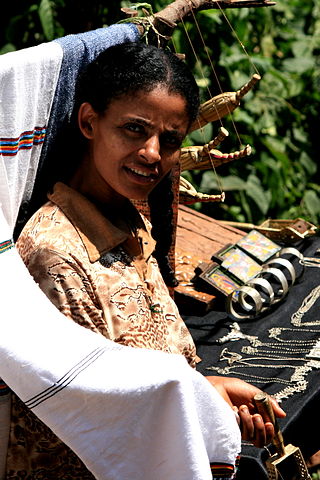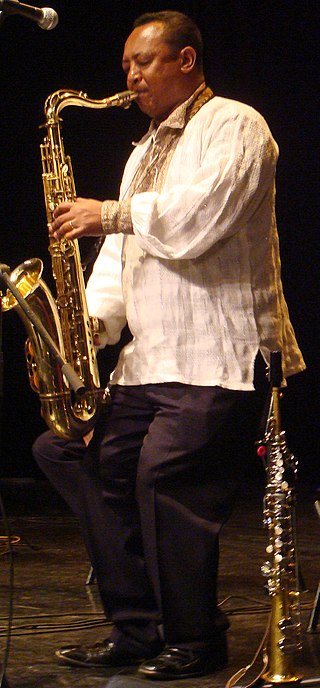History
| | This section needs expansion. You can help by adding to it. (February 2023) |
Ashenafi Kebede was one of the early scholars to standardize the kignits of northern and central Ethiopia.[ citation needed ]
Qañat or Qeñet (Amharic : ቅኝት, alternatively spelled Kignit, Keniet, Gegnet, Gignit) are secular musical scales developed by the Amhara ethnic group of Ethiopia. Qañat consists in a set of intervals defining the mode of a musical piece or the tuning scale of the instrument playing the piece. [1] There are four main qañat scales that are used, all of which are pentatonic: tizita (ትዝታ), bati (ባቲ), ambassel (አምባሳል), and anchihoye (አንቺሆዬ). [2] [3] Three additional modes are variations on the above: tezeta minor, bati major, and bati minor. [4] Some songs take the name of their qañat, such as tizita, a song of reminiscence. [3]
| | This section needs expansion. You can help by adding to it. (February 2023) |
Ashenafi Kebede was one of the early scholars to standardize the kignits of northern and central Ethiopia.[ citation needed ]

The major scale is one of the most commonly used musical scales, especially in Western music. It is one of the diatonic scales. Like many musical scales, it is made up of seven notes: the eighth duplicates the first at double its frequency so that it is called a higher octave of the same note.
In music theory, the key of a piece is the group of pitches, or scale, that forms the basis of a musical composition in Western classical music, art music, and pop music.
Tonality or key: Music which uses the notes of a particular scale is said to be "in the key of" that scale or in the tonality of that scale.
A pentatonic scale is a musical scale with five notes per octave, in contrast to heptatonic scales, which have seven notes per octave.
Articles related to music include:
Given the vastness of the African continent, its music is diverse, with regions and nations having many distinct musical traditions. African music includes the genres makwaya, highlife, mbube, township music, jùjú, fuji, jaiva, afrobeat, afrofusion, mbalax, Congolese rumba, soukous, ndombolo, makossa, kizomba, taarab and others. African music also uses a large variety of instruments from all across the continent. The music and dance of the African diaspora, formed to varying degrees on African musical traditions, include American music like Dixieland jazz, blues, jazz, and many Caribbean genres, such as calypso and soca. Latin American music genres such as cumbia, salsa music, son cubano, rumba, conga, bomba, samba and zouk were founded on the music of enslaved Africans, and have in turn influenced African popular music.

Krar is a five-or-six stringed bowl-shaped lyre from Ethiopia and Eritrea. It is tuned to a pentatonic scale. A modern Krar may be amplified, much in the same way as an electric guitar or violin. The Krar, along with Masenqo and the Washint, is one of the most widespread musical instruments in Northern Ethiopia and Eritrea.
Ethiopian music is a term that can mean any music of Ethiopian origin, however, often it is applied to a genre, a distinct modal system that is pentatonic, with characteristically long intervals between some notes.

Amharas are a Semitic-speaking ethnic group indigenous to Ethiopia, traditionally inhabiting parts of the northwest Highlands of Ethiopia, particularly inhabiting the Amhara Region. According to the 2007 national census, Amharas numbered 19,867,817 individuals, comprising 26.9% of Ethiopia's population, and they are mostly Oriental Orthodox Christian.
Dorian mode or Doric mode can refer to three very different but interrelated subjects: one of the Ancient Greek harmoniai ; one of the medieval musical modes; or—most commonly—one of the modern modal diatonic scales, corresponding to the piano keyboard's white notes from D to D, or any transposition of itself.
A borrowed chord is a chord borrowed from the parallel key. Borrowed chords are typically used as "color chords", providing harmonic variety through contrasting scale forms, which are major scales and the three forms of minor scales. Chords may also be borrowed from other parallel modes besides the major and minor mode, for example D Dorian with D major. The mixing of the major and minor modes developed in the Baroque period.

The Culture of Africa is varied and manifold, consisting of a mixture of countries with various tribes depicting their unique characteristic and trait from the continent of Africa. It is a product of the diverse populations that inhabit the continent of Africa and the African diaspora. Generally, Culture can be defined as a collective mass of distinctive qualities belonging to a certain group of people. These qualities include laws, morals, beliefs, knowledge, art, customs, and any other attributes belonging to a member of that society. Culture is the way of life of a group of people.

The Andalusian cadence is a term adopted from flamenco music for a chord progression comprising four chords descending stepwise – a iv–III–II–I progression with respect to the Phrygian mode or i–VII–VI–V progression with respect to the Aeolian mode (minor). It is otherwise known as the minor descending tetrachord. Traceable back to the Renaissance, its effective sonorities made it one of the most popular progressions in classical music.

Mahmoud Ahmed is an Ethiopian singer. He gained great popularity in Ethiopia in the 1970s and among the Ethiopian diaspora in the 1980s, before rising to international fame with African music fans in Europe and the Americas.
Kuku Sebsibe is an Ethiopian singer. She generally performs with synthesizer and drum machine accompaniment, occasionally with the addition of traditional instruments such as the krar or other instruments such as the electric guitar. While she uses modern instruments and harmonies, her vocal style is essentially traditional, using modes such as tizita.
The Hungarian minor scale, double harmonic minor scale, or Gypsy minor scale is a type of combined musical scale. It is the same as the harmonic minor scale, except that it has a raised fourth scale degree to introduce an additional gap, or augmented second. It is a symmetrical scale with a slightly ambiguous tonal centre, due to the many half steps.

An Azmari is an entertainer who sings and plays traditional string instruments of the Ethiopian Highlands. They are comparable to medieval European minstrels, bards or West African griots.

Abatte Barihun is an Israeli jazz saxophonist and composer. His sound is reminiscent of John Coltrane's, who has highly influenced Barihun.
Tizita is one of the Pentatonic scales or Qañat of the Amhara ethnic group.
Music and politics have been closely intertwined throughout the history of Ethiopia.
The Ethiopian Golden Age of Music was an era of Ethiopian music that began around the 1960s to 1970s, until the Derg regime progressively diminished its presence through politically motivated persecutions and retributions against musicians and companies, which left many to self-imposed exile to North America and Europe. Several artists and musical companies, as well as recording groups, emerged to produce their own singles and albums; the first being Amha Records, and Philips Records, Ethiopia Records and Kaifa Records, which is primarily based in Addis Ababa.